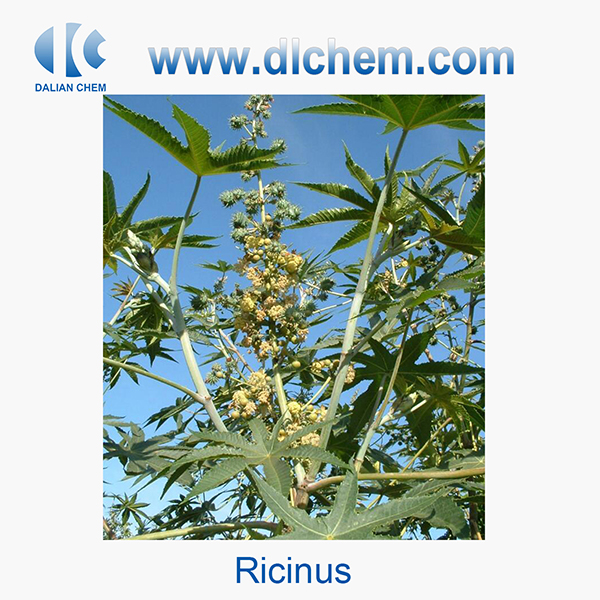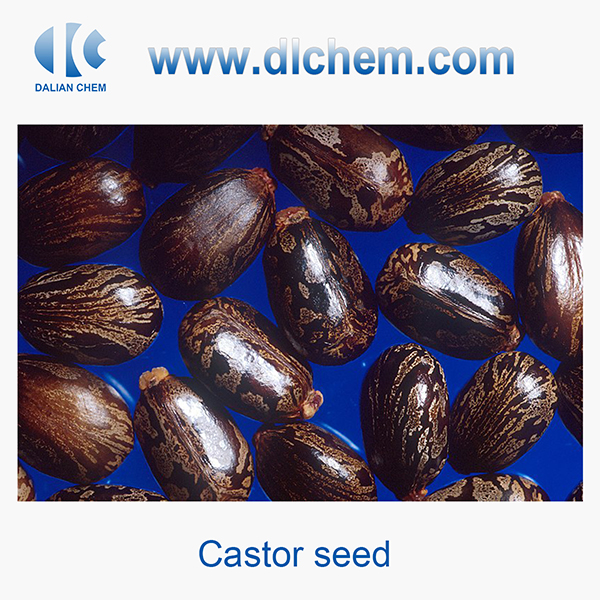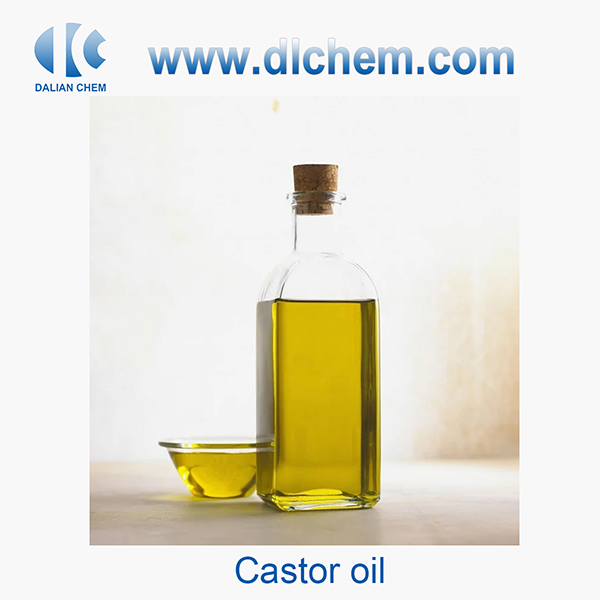 DALIAN CHEM
DALIAN CHEM
Ricinus communis, is native to Egypt, Ethiopia and India, and later spread to Brazil, Thailand, Argentina, the United States and other countries. Widely distributed in tropical regions of the world or cultivated in tropical to warm countries, and widely grown elsewhere as an ornamental plant.

Ricinus's seed is the castor bean, which, despite its name, is not a true bean. Castor seed is the source of castor oil, which has a wide variety of uses. The seeds contain between 40% and 60% oil that is rich in triglycerides, mainly ricinolein. The seed also contains ricin, a water-soluble toxin, which is also present in lower concentrations throughout the plant.
The chemical composition of castor seeds is mainly oil content, which varies according to the variety and origin. The oil content of the red and green stems of castor seeds produced in Asia, Persia and other countries is about 42%. The stem and leaf fruits produced in India and North Africa are all reddish brown and the oil content is about 50%. Northeast castor is divided into red stems and white stems (including thorns and non-thorns). Its chemical composition is: oil content 40% -50%; carbohydrate and crude fiber 20% -30%; crude Protein 15% - 18% ash is 2% - 3%.
At present, China's castor seed production ranks second in the world, second only to India. China is the second largest castor planting country in the world, and the demand for castor oil is large, with a gap of over 70%.

The common name "castor oil" probably comes from its use as a replacement for castoreum, a perfume base made from the dried perineal glands of the beaver (castor in Latin).[7] It has another common name, palm of Christ, or Palma Christi, that derives from castor oil's reputed ability to heal wounds and cure ailments.
Castor oil is obtained by pressing or solvent extraction from castor seeds according to different uses. Castor oil is mainly a glyceride of higher fatty acids composed of ricinoleic acid (12-hydroxyoctadec-9-enoic acid) and oleic acid It is a triglyceride of fatty acids, which is a viscous liquid, colorless or slightly yellow, light bitter, slightly bitter and slightly odorous.
Three terpenoids and a tocopherol-related compound have been found in the aerial parts of Ricinus. Compounds named (3E,7Z,11E)-19-hydroxycasba-3,7,11-trien-5-one, 6α-hydroxy-10β-methoxy-7α,8α-epoxy-5-oxocasbane-20,10-olide, 15α-hydroxylup-20(29)-en-3-one, and (2R,4aR,8aR)-3,4,4a,8a-tetrahydro-4a-hydroxy-2,6,7,8a-tetramethyl-2-(4,8, 12-trimethyltridecyl)-2H-chromene-5,8-dione were isolated from the methanol extracts of Ricinus communis by chromatographic methods. Partitioned h-hexane fraction of Ricinus root methanol extract resulted in enrichment of two triterpenes: lupeol and urs-6-ene-3,16-dione (erandone). Crude methanolic extract, enriched n-hexane fraction and isolates at doses 100 mg/kg p.o. exhibited significant (P < 0.001) anti-inflammatory activity in carrageenan-induced hind paw oedema model.
Castor oil has high oil viscosity and low freezing point. It is resistant to severe cold and high temperature. It does not freeze at -8~-10 ℃ and does not solidify and denature at 500~600 ℃. It has good stability, color retention and flexibility. Pigment dispersibility, wettability, lubricity, low temperature characteristics, electrical characteristics and biological characteristics are different from other greases. It is an important industrial oil for chemical industry, light industry, metallurgy, electromechanical, textile, printing, dye and other industries and medicine. It can be used as surfactant, fatty acid glyceride, fatty glycol, dry oil, sebacic acid, polymerized Stabilizers and plasticizers, foam plastics and elastic rubber. It is also a raw material for advanced lubricants. Can also be used as a medicament, has a laxative effect.
Castor oil is insoluble in water, soluble in ethanol, benzene and carbon disulfide. It can be arbitrarily mixed with absolute ethanol, ether, chloroform or glacial acetic acid, but insoluble in mineral oil.
Castor oil relative density 0.956~0.969 (25 ℃), refractive index 1.478~1.480, acid value <= 2.0, iodine value (g iodine / 100g oil) 82-86, saponification value (mgKOH / g oil) 176-187, sulfur Cyanide value 81-82, total fatty acid content (%) about 96, average molecular weight of fatty acid 290-300,
Fatty acid composition of castor oil (%):
Stearic acid 0.5-3.0
Dihydroxystearic acid 0.6-2.0
Oleic acid 3-9
Linoleic acid 2.0-3.5
Ricinic acid 80-88
Castor oil is divided into two types: medicinal and industrial: medicinal castor oil is an irritant laxative; in addition to medicinal, industrial uses are more extensive:
It is the raw material for the production of sebacic acid, Turkish red oil, secondary octanol, hydrogenated castor oil, dodecyl stearic acid, heptanal and other important chemical products. Widely used in plasticizers, dibasic acids, polyurethane coatings, rubber, adhesives, fatty acids, surfactants, insulating oils, hydraulic oils, lubricating oils, Turkish red oils, soaps, polyamide-11 fibers, etc .; Perfume, penetrant and emulsifier for textile industry; extender and brightener for leather finishing, etc.
Although the field of castor oil is very extensive, its supply is very concentrated. The annual supply of castor oil from India accounts for about 95% of the world's total supply; China is the second largest producer of castor oil,at around 4%.The supply in other countries is negligible and the impact on the market is negligible.
Due to the inability to mechanize the harvesting of castor seeds, China's castor seed production has fallen to a very low level in recent years due to the rapid rise in labor costs in China. Compared with India, China ’s castor seed production is almost negligible. According to estimates by domestic industry experts, China ’s castor seed production in 2018 was only about 6,000 tons. According to the 45% oil yield, the annual supply of castor oil is only It is about 2,700 tons, which is less than half a month of the largest castor oil deep-processing enterprise in China. China's huge annual consumption of castor oil is almost entirely dependent on imports. It can be said that China's castor oil industry's dependence on imports far exceeds China's dependence on oil imports.
Castor oil is an important industrial oil, so its consumption has an important relationship with the degree of industrial development. From the perspective of India ’s castor oil export, major industrial producers such as China, the European Union, the United States, Japan, and South Korea are the main export destinations of Indian castor oil. The Indian castor oil consumed by these industrial countries accounts for 80% of India’s total exports.
